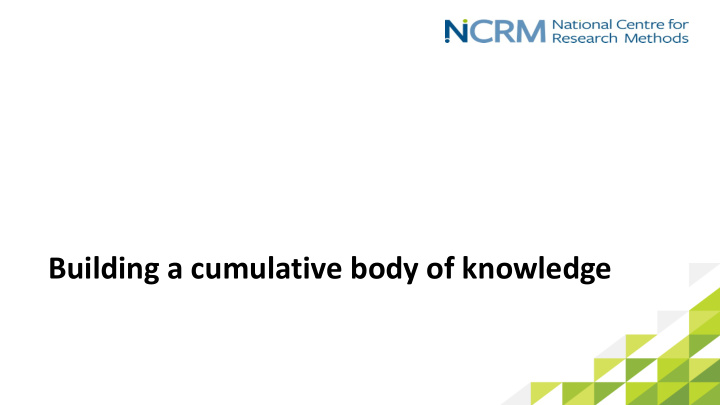



Building a cumulative body of knowledge
• Community studies have evolved as more sophisticated methods have emerged, as well as in response to criticisms. • One example is the development of on-line research methods to study on-line communities.
• However, change is evolutionary. • Social network analysis, visual methods and interviewing are also among long-used methods that have become more sophisticated.
• A key criticism of community studies was that they did not generate a cumulative body of knowledge. • Early attempts to synthesise findings from different studies fell down because theoretical expectations were not confirmed.
• Findings showed that geographical location does not determine social behaviour. • The rural-urban continuum had to be abandoned because it could not deal with phenomena such as ‘urban villagers’.
• The view that researchers bring their own values to the field and find what they are looking for casts doubt on research being straightforwardly cumulative.
• Subsequently, researchers have been more mindful of how choice of theory and methods affect findings, and of the need for transparency.
• Re-studies have become an important way in which community studies contribute to knowledge and understanding of social change.
• Robert and Helen Lynd were pioneers of this approach, following Middletown (1929) with Middletown in Transition (1937).
• Another re-study is Geoff Dench and his colleagues’ The New East End (2006), revisiting East London half a century on. • Patterns of migration and economic change had transformed the area.
• This re-study included one of the original researchers, Michael Young, but re-studies can be conducted by wholly new individuals or teams.
• Re-studies are generally quicker to conduct than completely new studies. • The original study will have set a research agenda that can be revisited.
• The same point applies to the choice of research methods used. • Community members may be familiar with the research process, so making the negotiation of access quicker.
• Openness about the research process by the original research team and methodical archiving of materials bring invaluable benefits for any re-studies.
• How long is allowed to pass before a re-study is contemplated varies, but somewhere around a generation is typical.
• Middletown continues to be studied, recently as an interdisciplinary project. • The Other Side of Middletown (Eric Lassiter et al. 2004).
• The project explored the lives of Muncie’s African -American community, which previous research had generally overlooked. • Three quarters of a century of research had still left a ‘missing piece of the puzzle’.
• Students from several disciplines. • Fieldwork completed in 4 months in 2003, 300-page book published in 2004.
• Other social groups overlooked in previous research include women in male-dominated environments, children, and older people.
• Researchers may naturally gravitate towards ‘nice’ people, and as a result produce accounts that are too good to be true.
• Concern not to offend community sensitivities may also pull research reports towards an overly-positive account.
• Nancy Scheper- Hughes’ Saints, Scholars and Schizophrenics dealt with the sensitive subject of mental illness and she was unwelcome when returning to Ireland two decades later. • The book’s 2001 second edition reflects thoughtfully on this.
• Critical social science does not have to be antagonistic in its treatment of taboo subjects. • The Other Side of Middletown broached the issue of racism successfully.
• Ray Pahl researched the hidden economy of illegal working. • Karen O’Reilly (2000) was able to get beyond the implausibly positive gloss put on life in the British expat community in Spain, and later to return.
• These three studies are used as exemplars of community study research in my 2018 book What Are Community Studies? • They are all in their different ways both rigorous and imaginative.
• They have contrasting research designs, scales, and methodological approaches. • But they all demonstrate the potential of community studies to add to the stock of useful and interesting social scientific knowledge.
Recommend
More recommend